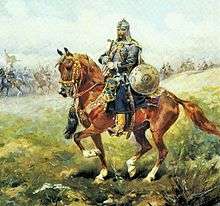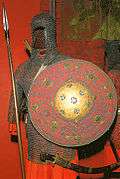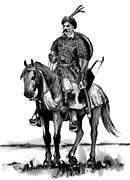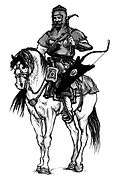Towarzysz pancerny
A Towarzysz pancerny (Polish: [tɔˈvaʐɨʂ panˈtsɛrnɨ], "armoured companion"; plural: towarzysze pancerni, or pancerni) was a medium-cavalryman in 16th to 18th century Poland, named after their chainmail armor ("pancerz"). These units were the second-most-important (and successful) cavalry in the Polish-Lithuanian army, after the hussars.
| Towarzysz pancerny | |
|---|---|
 | |
| Allegiance | |
| Type | cavalry |
| Role | Standing professional military |
| Equipment | war hammer, Mace (bludgeon), hatchet, sabre spear Lance |
Most pancerni were recruited from the middle or lower classes of the Polish (or Lithuanian) nobility. They were organized into companies, with each company (Polish: chorągiew or rota) consisting of 60 to 200 horsemen.
Arms
They used chainmail or bechter armour to protect the upper body, karwasze sometimes with gauntlets, secretes (rarely Szyszak helmet), buckler shields, Polish sabre, reflex bow, gunpowder weapons, (such as flintlock pistols, arquebus or muskets, and early carabines). Earlier companies would sometimes be equipped with a horseman's pick, a short spear, or a lance. During the rule of king John III Sobieski, polearms became compulsory.
During the Middle Ages, under the rule of Mieszko I and Bolesław I the Brave, the name pancerni applied to the members of the duke's retinue. They were the wealthiest warriors in the Polish army, and as such they could afford to wear sophisticated armour, most commonly chainmail. Their weapons included arming swords, axes, spears, shields, strait bows, and nasal helmets.
Culture
In modern Polish, "pancerni" also means "tank men", as in the title of the book and TV series, Czterej pancerni i pies (Four Tank Men and a Dog). The word "pancerny" is seldom used in that context, however, with the common word being "czołgista" (from "czołg", "tank").
See also
- Polish cavalry
- Towarzysz
- Poczet
- Pocztowy
- Offices in the Polish-Lithuanian Commonwealth
- Petyhorcy


